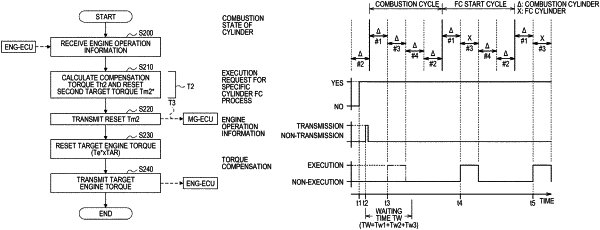| CPC B60W 20/10 (2013.01) [B60W 10/06 (2013.01); B60W 10/08 (2013.01); F02D 17/02 (2013.01); F02D 41/30 (2013.01); B60W 2510/0657 (2013.01); B60W 2710/0616 (2013.01); B60W 2710/083 (2013.01)] | 3 Claims |

|
1. A control device for a hybrid vehicle that is applied to a hybrid vehicle in which an internal combustion engine including a plurality of cylinders and an electric motor which are mounted as drive power sources, the control device comprising:
a first processor or dedicated hardware circuit; and
a second processor or dedicated hardware circuit,
wherein the first processor or dedicated hardware circuit is configured to perform a specific cylinder fuel cutoff process of stopping combustion of an air-fuel mixture in some cylinders out of the plurality of cylinders and a transmission process of transmitting engine operation information on execution of the specific cylinder fuel cutoff process to the second processor or dedicated hardware circuit,
wherein the second processor or dedicated hardware circuit is configured to perform a torque compensation process of controlling the electric motor based on the received engine operation information such that at least a part of a decrease in engine torque due to execution of the specific cylinder fuel cutoff process is compensated for by an output torque of the electric motor,
wherein the first processor or dedicated hardware circuit is configured to perform a process of starting the specific cylinder fuel cutoff process in a combustion cycle when a prescribed waiting time has elapsed after the transmission process has been performed, and
wherein the waiting time includes a time until the second processor or dedicated hardware circuit receives the engine operation information after the first processor or dedicated hardware circuit has transmitted the engine operation information to the second processor or dedicated hardware circuit.
|